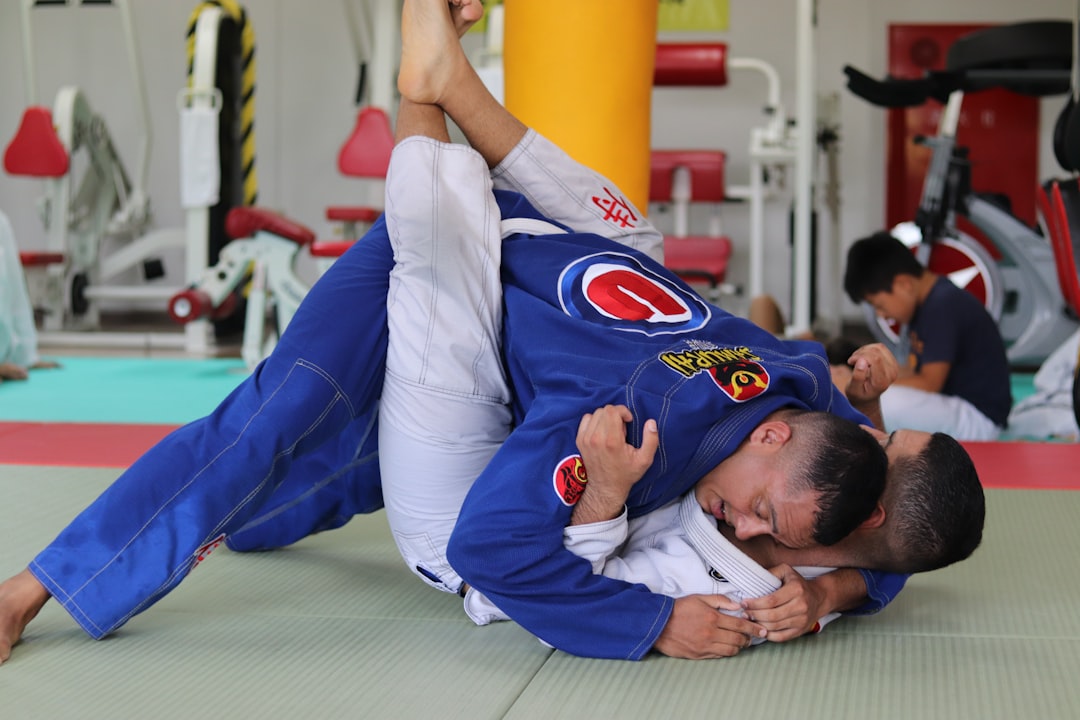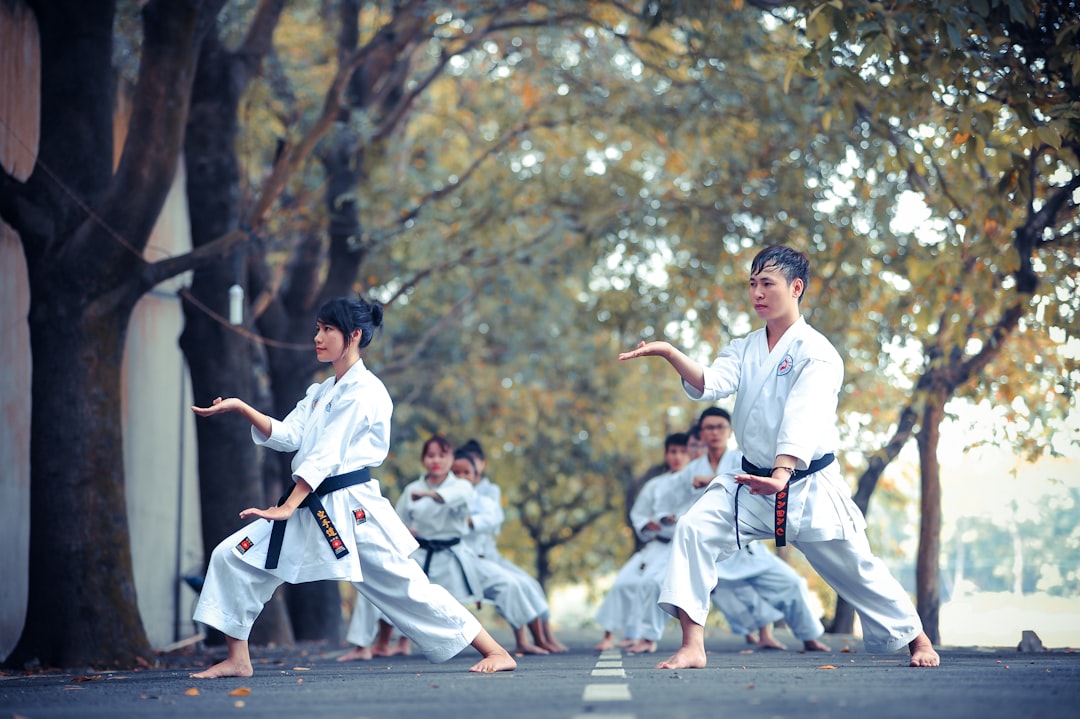When training karate at home, wearing a traditional karate gi is not just a tradition but a practical choice that facilitates movement and supports the execution of techniques. The gi's design—a jacket with a waist loop and hip pockets, straight-legged trousers, and an obi belt—honors the discipline's heritage while ensuring comfort and uniformity among practitioners worldwide. Selecting the right size and material, such as cotton or hemp, is key for mobility and durability during practice, with white often preferred symbolizing purity and humility. While there are no strict rules for home training attire, it's important to choose a gi that fits well without restricting movement and to maintain it through regular washing and air drying to preserve its quality and grip. Proper care extends the gi's lifespan and ensures a consistent training experience. Home practitioners should be aware of the modern advancements in gi design, such as pre-sewn creases and reinforcements, which enhance durability while upholding karate's disciplined ethos and cultural values. Regular maintenance, including using mild detergent without fabric softeners and adhering to manufacturer guidelines, is crucial for keeping the gi in optimal condition for ongoing practice at home.
karate practitioners worldwide recognize the significance of the traditional garb, the karate gi. This article demystifies the essential training attire, offering insights into its evolution and role in both traditional and contemporary martial arts practice. Whether you’re training karate at home or in a dojo, understanding the karate gi is pivotal for any enthusiast. We will explore its history, significance, and provide valuable tips on selecting and maintaining your own gi, enhancing your home training sessions.
- Understanding the Karate Gi: The Essential Training Attire for Home Practice
- The Evolution and Significance of the Karate Gi in Traditional and Modern Practice
- Tips for Choosing and Maintaining Your Own Karate Gi for Home Training Sessions
Understanding the Karate Gi: The Essential Training Attire for Home Practice

When practicing karate at home, donning the appropriate attire is crucial for both comfort and formality. The karate gi, a traditional martial arts uniform, serves as essential training attire that offers functionality and respect for the discipline. Made of cotton or hemp, the gi allows for ease of movement, which is vital when executing various karate techniques and forms. It also provides a sense of unity and tradition among practitioners worldwide. What exactly constitutes a karate gi? Typically, it consists of a jacket, trousers, and a belt, known as an obi, which holds the garment closed in front. The jacket is designed with a belt loop at the waist and two or four pockets on each hip. The trousers are straight-legged and hemmed to just above the ankle. For those training karate from the comfort of their home, understanding the components of the gi is essential for proper attire. Are there any specific considerations when selecting a gi for home practice? While there is no strict requirement for color or style in a home setting, it’s common to choose a white gi, as it symbolizes purity and humility—key virtues in karate practice. Additionally, the size should fit comfortably without being too loose or restrictive, allowing full range of motion and ensuring no fabric interferes with techniques. Whether you’re a beginner or an advanced practitioner training karate at home, the gi remains a traditional and practical choice for your martial arts journey.
The Evolution and Significance of the Karate Gi in Traditional and Modern Practice

The karate gi, a traditional training outfit, has undergone significant evolution over the years to meet both functional and stylistic demands in both traditional and modern practice. Originally, practitioners wore simple cotton kimonos before transitioning to the more structured gi we recognize today. Made of cotton or hemp, the gi serves as a versatile garment that allows for ease of movement during practice while also providing a uniformity among practitioners. In traditional settings, the gi symbolizes humility and respect for the martial art, a testament to its deep-rooted cultural significance. Today, with the rise of training karate at home, the design and materials of the gi have adapted to accommodate individual practice environments, offering variations that cater to comfort and accessibility. What began as a simple garment has thus become a multifaceted symbol of discipline, respect, and tradition in the world of karate.
Training karate at home has necessitated adjustments to the traditional gi. Modern versions often feature pre-sewn creases and reinforcements in high-stress areas for durability and longevity. Additionally, they come in a variety of weights and cuts, including women’s and men’s styles, to ensure that every practitioner can find a gi that fits their body type and practice conditions effectively. The question of whether the gi has lost its traditional significance is often posed in light of these modern adaptations. However, the answer lies in its continued use as a uniform for discipline, tradition, and respect within the martial art, which remains unchanged despite the evolutions in its design.
Tips for Choosing and Maintaining Your Own Karate Gi for Home Training Sessions

When selecting a karate gi for home training sessions, it’s key to consider the material and fit to ensure comfort and durability during practice. A high-quality cotton or hemp blend is often preferred for its breathability and ability to withstand repeated movements. When you train karate at home, having a gi that fits well cannot be overstated; it should not only be the appropriate size but also offer freedom of movement for techniques like kicks and blocks. Additionally, the collar should neither be too tight nor too loose around your neck, as this can be distracting or even restrictive. Proper maintenance of your karate gi is equally important. Regularly washing your gi after intense training sessions will help maintain its condition and remove any odors that may linger after sweating. It’s advisable to use a mild detergent and avoid fabric softeners, as these can affect the gi’s texture and grip. Air drying your gi is recommended to prevent shrinkage and damage to the fabric from high heat. Remember, a well-maintained karate gi will not only last longer but also provide a more comfortable and effective training experience every time you train karate home. How often do you wash your karate gi? Aim to clean it after each use to maintain both hygiene and the integrity of the fabric. Can you machine wash your karate gi? Yes, you can machine wash your karate gi on a gentle cycle using a mild detergent, but make sure to follow the specific care instructions provided by the manufacturer to avoid any potential damage.
In wrapping up our exploration of the karate gi, it’s clear that this versatile training suit plays a pivotal role in both traditional and modern karate practice. Whether you’re honing your skills at home or within a dojo, the karate gi—or keikogi—represents not only the unity of tradition with contemporary training like ‘train karate home’ but also the discipline and respect inherent to the martial art. By understanding the significance of the garment and knowing how to select and care for your own, you can fully immerse yourself in the practice, ensuring that each movement is performed with authenticity and precision. As a final note, embracing the essence of karate through the proper attire enriches not just the training experience but also the journey of self-improvement and mastery that karate offers.
